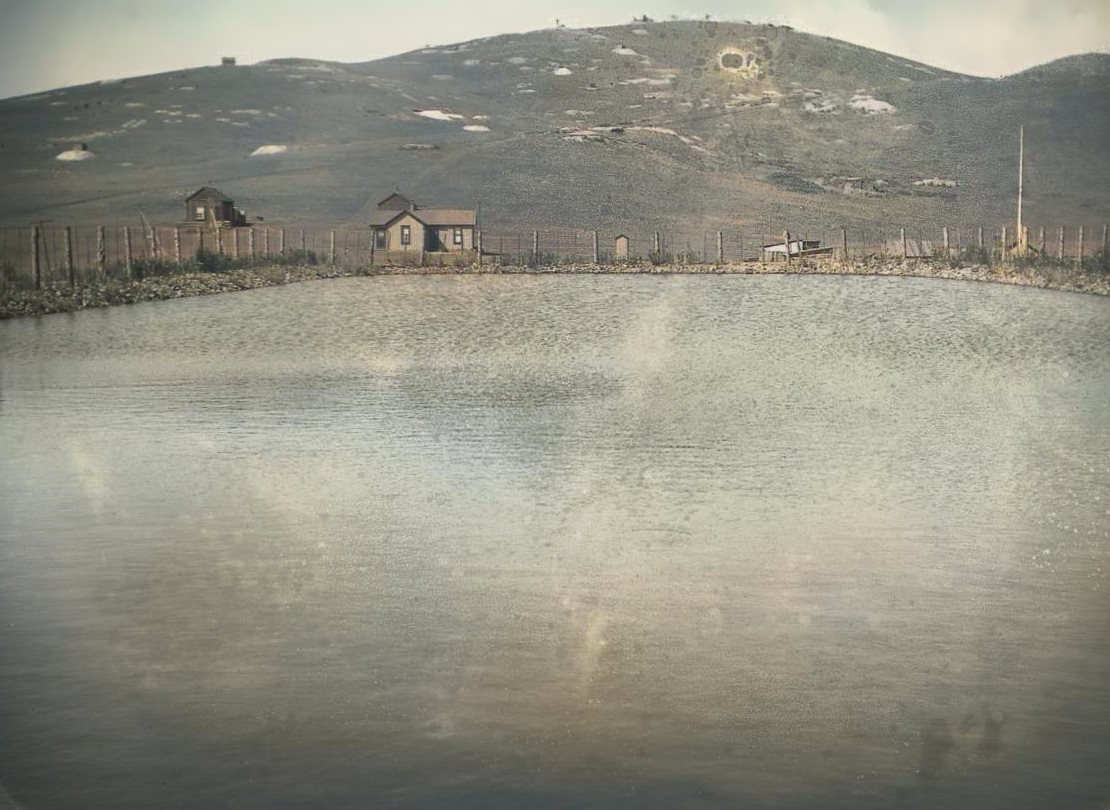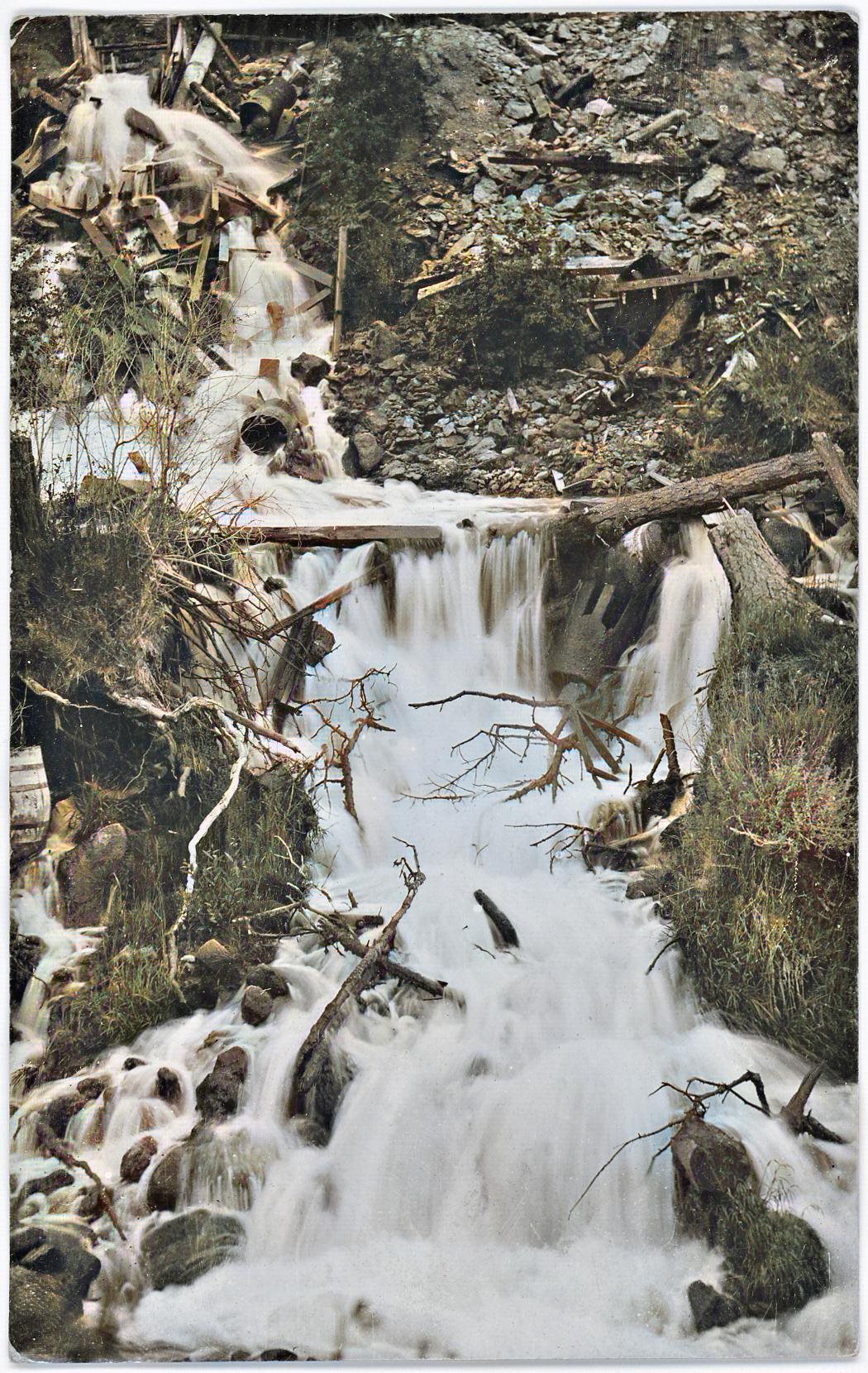-> Found at Hathi Trust Digital Library website, link to page.
Source had no pics, so I added from my collection
The underground water is stored water. There are no unusual conditions of depth of ground-water surface. Water in shafts was encountered at moderate depths averaging 9,500 ft. above sea level.
The depth at which water was reached varied from 910 ft. in the Isabella to 35 ft. in the Mary McKinney.
As shafts were deepened ground water interfered with development. Mines began pumping in 1895. The burden lay on a few of the deepest mines.
Tunnel Drainage.
The Blue Bell tunnel, near Anaconda, was the first to encounter water. This, which enters the granite at 9,335 ft., or 15 ft. below the average water level, had a flow of 200 gal. per minute and the flow persisted for several years.
The Ophelia tunnel, 2,600 ft. long, discharged 2,000 gal. per minute. This water came from the breccia or from fissure zones connected with the main volcanic neck. It flowed for a year and in 1898 ran dry when the Standard tunnel began to drain.
In 1896 the Standard cut the El Paso vein, whence issued 250 gal. per minute. The water became abundant as the contact of granite and phonolite was reached, amounting to 1,000 gal. per minute. In 1899 it was 10,000 gal. per minute. By 1901 the tunnel was dry, lowering the levels in Beacon hill, Gold hill and Raven hill.
The El Paso tunnel, the lowest of the drainage tunnels, at 8,783 ft. above sea level and below the mouth of Arequa gulch, was begun in January, 1903, and on Sept. 6 connection was completed with the lowest levels of the El Paso.
The history of the water in the Elkton shows that the water is confined to fissures and does not belong to a general underground body. At Arequa, for example, is a spring that has not been affected by the workings of the Elkton, close to it. All the existing drainage tunnels have tapped the breccia-filled volcanic neck from the west.
The Standard tunnel was directed towards the plug of phonolite of Beacon hill, which was connected by open fissures with the volcanic neck, and it lowered the water levels of the West Side mines.
The Eclipse mine appears to have an impervious water pocket of its own.
The Standard tunnel drains the Gold Hill at the Poverty Gulch mine. The behavior of the water in five of the prominent mines shows they have a common water basin, any artificial change in one mine being felt and adjusted in the others.
On the other hand, a tunnel like the El Paso may not affect materially the drainage of some other mines near it, showing that there are local basins of water within the main water area. Of the different sites chosen for a deep drainage, the El Paso at present is the lowest. It is believed that the quantity of stored water decreases as great depth is gained.
Great bodies of water, however, have been encountered 400 ft. below the El Paso drainage, showing that there are still water-bearing fissures at great depth. The El Paso lowered the water in the Mary McKinney and Elkton, showing a connection to open fissures between Beacon hill phonolite and the main volcanic neck.
Conditions of Water Storage.
The volcanic neck of breccia contains a body of water prevented from escaping by the impervious nature of the old crystalline rocks with which it is surrounded. It is like a water-soaked sponge in a glass cup. The behavior, character and temperature of the underground water indicate a meteoric origin from rain and snow falling on the district.
For practical purposes the underground water is to be regarded as occupying a number of separate basins.
The Elkton mine was one of those most troubled by water. The first water was on level No. 3, or 9,423 ft. above sea level; the flow ranged from 400 gal. to 600 gal. per minute, but after a few months this ran dry, probably drained by the Ophelia tunnel.
Successively larger flows were met with at greater depths on levels Nos. 5 and 6, drained by the Standard tunnel. Drifting was resumed and the mine was made dry until February, 1901, when on level No. 7 a large cavity was tapped which drowned the pumps at level No. 8 and rose to 45 ft. above level No. 7.
The levels were recovered by pumping and bulkheading the source. On Sept. 6, 1903, the tunnel was completed to the El Paso mine, and the first rush of accumulated water soon subsided to the normal flow.
A few days after the El Paso tunnel cut into the great water course that raised the flow from 2,000 gal. to 5,000 gal. per minute, and the water fell rapidly in the Elkton, showing that the rate of fall of the Elkton water is limited by the flowing capacity of the natural fissure which afforded the first great flow in the mine.

